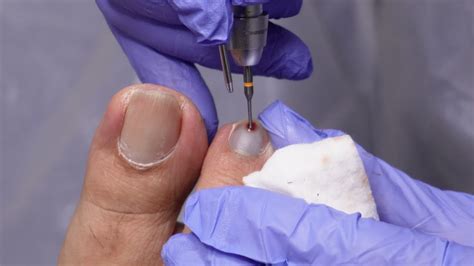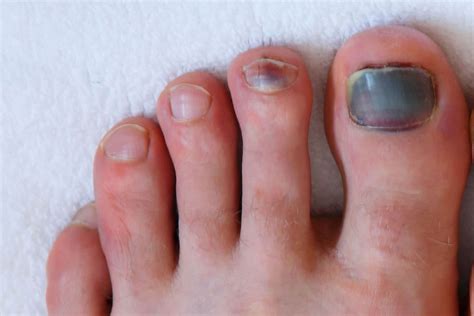Intro
Discover causes of blood under toenail, including trauma, injury, and nail fungus. Learn about symptoms, treatment, and prevention of subungual hematoma and nail plate issues.
The presence of blood under a toenail can be a painful and unsettling experience. It's essential to understand the potential causes of this condition to seek proper treatment and prevent further complications. Blood under the toenail, also known as subungual hematoma, can result from various factors, including injuries, medical conditions, and lifestyle habits. In this article, we'll delve into the possible causes of blood under the toenail and discuss the necessary steps to address this issue.
The toenail is a sensitive area, and any trauma or pressure can cause blood to accumulate underneath. This can lead to discoloration, pain, and swelling. In some cases, the blood under the toenail may be a sign of an underlying medical condition that requires attention. It's crucial to identify the root cause of the problem to receive appropriate treatment and prevent future occurrences. Whether it's a minor injury or a more severe condition, understanding the causes of blood under the toenail is vital for maintaining good foot health.
The human foot is a complex structure, comprising bones, muscles, and nerves that work together to facilitate movement and balance. The toenail, although a small part of the foot, plays a significant role in protecting the sensitive tips of the toes. When blood accumulates under the toenail, it can be a sign of an underlying issue that needs to be addressed. By exploring the possible causes of blood under the toenail, individuals can take proactive steps to prevent this condition and maintain overall foot health.
Blood Under Toenail Symptoms

Types of Subungual Hematoma
There are two primary types of subungual hematoma: traumatic and non-traumatic. Traumatic subungual hematoma occurs when there is a direct injury to the toenail, such as dropping a heavy object on the toe or stubbing the toe. Non-traumatic subungual hematoma, on the other hand, can result from medical conditions like diabetes, poor circulation, or nerve damage. Understanding the type of subungual hematoma is crucial for determining the best course of treatment.Blood Under Toenail Causes

It's essential to identify the underlying cause of blood under the toenail to receive proper treatment. In some cases, the condition may resolve on its own with rest and self-care. However, if the symptoms persist or worsen, medical attention is necessary to prevent further complications.
Treatment Options
The treatment for blood under the toenail depends on the underlying cause and severity of the condition. In some cases, self-care measures like rest, ice, and elevation may be sufficient. However, if the condition is caused by an underlying medical condition, treatment may involve medication, surgery, or other interventions. It's crucial to consult a medical professional for proper diagnosis and treatment.Blood Under Toenail Prevention

By following these preventive measures, individuals can reduce the risk of developing blood under the toenail and maintain overall foot health.
Complications
If left untreated, blood under the toenail can lead to complications like infection, nerve damage, or permanent discoloration of the toenail. In severe cases, the condition may require surgical intervention to drain the hematoma or remove the affected toenail. It's essential to seek medical attention if symptoms persist or worsen over time to prevent these complications.Blood Under Toenail Home Remedies

It's essential to note that these home remedies may not be suitable for everyone, especially those with underlying medical conditions. Consult a medical professional before trying any home remedies.
When to Seek Medical Attention
It's crucial to seek medical attention if the symptoms of blood under the toenail persist or worsen over time. Some signs that indicate the need for medical attention include: * Increasing pain or swelling * Pus or discharge from the affected toenail * Fever or chills * Redness or warmth around the affected toenail * Difficulty walking or bearing weight on the affected footBy seeking medical attention promptly, individuals can prevent further complications and receive proper treatment for the underlying cause of blood under the toenail.
Blood Under Toenail Treatment Options

It's essential to consult a medical professional to determine the best course of treatment for the specific condition.
Lifestyle Modifications
In some cases, lifestyle modifications may be necessary to address the underlying cause of blood under the toenail. Some common lifestyle modifications include: * Improving circulation through regular exercise * Managing diabetes or other underlying medical conditions * Avoiding tight or constricting footwear * Keeping the feet and toes clean and dry * Getting regular foot check-upsBy making these lifestyle modifications, individuals can reduce the risk of developing blood under the toenail and maintain overall foot health.
Blood Under Toenail Prognosis

Conclusion and Next Steps
In conclusion, blood under the toenail is a condition that requires attention and proper treatment. By understanding the potential causes, symptoms, and treatment options, individuals can take proactive steps to address the underlying cause and prevent further complications. If you're experiencing symptoms of blood under the toenail, it's essential to consult a medical professional for proper diagnosis and treatment. Remember to prioritize foot health and take preventive measures to reduce the risk of developing this condition.What are the common causes of blood under the toenail?
+The common causes of blood under the toenail include injury or trauma, poorly fitting shoes or socks, fungal infections, bacterial infections, diabetes, poor circulation, and nerve damage.
How can I prevent blood under the toenail?
+To prevent blood under the toenail, wear properly fitting shoes and socks, avoid tight or constricting footwear, keep the feet and toes clean and dry, trim toenails straight across, and get regular foot check-ups.
What are the symptoms of blood under the toenail?
+The symptoms of blood under the toenail include pain, swelling, and discoloration of the affected toenail. In some cases, the toenail may become loose or fall off.
When should I seek medical attention for blood under the toenail?
+Seek medical attention if the symptoms of blood under the toenail persist or worsen over time, or if you experience increasing pain or swelling, pus or discharge, fever or chills, or difficulty walking or bearing weight on the affected foot.
How is blood under the toenail treated?
+The treatment for blood under the toenail depends on the underlying cause and severity of the condition. Treatment options may include antibiotics, antifungal medications, pain relievers, surgery, and lifestyle modifications.
